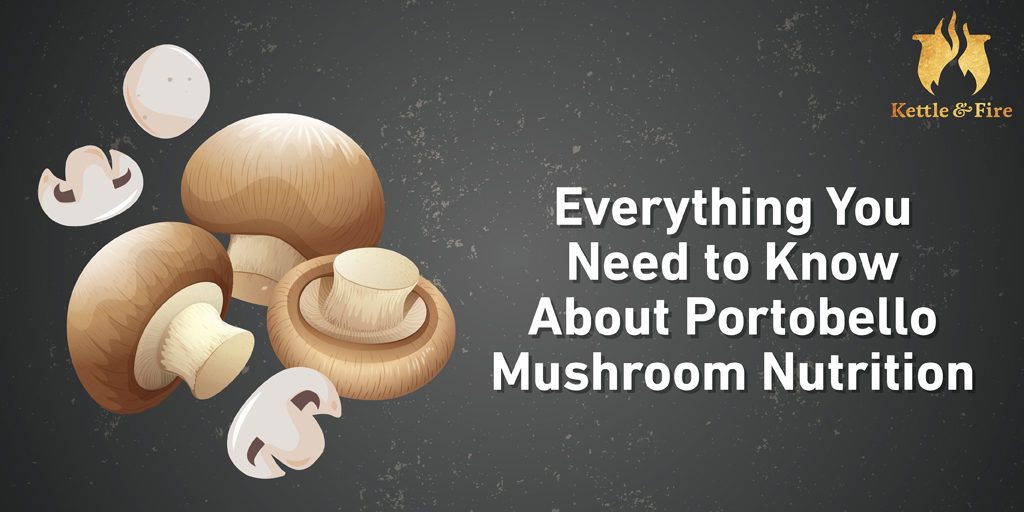Everything You Need to Know About Portobello Mushroom Nutrition

It can be a challenge to find delicious meat substitutes, especially for vegetarians who have chosen the lifestyle for health reasons. So many meat alternatives, especially those that come in the form of patties or other processed food items, don’t pass muster for those striving to eat a healthy diet.
You’ve probably seen a portobello mushroom burger listed as a vegetarian option in restaurants. If you’ve tried one, you probably noticed that they have a good bite to them – they don’t quite have the texture of meat, but they’re substantial, and they can be seasoned in any number of ways to enhance their umami flavor and bring out whatever meatiness hides inside.
Portobello mushroom nutritional value, while high in a number of important areas, has one downfall. It’s low in protein compared to animal sources. The average 1-cup serving of portobello mushroom provides about 5 grams of protein (1).
So, you’ll need to do some thoughtful food pairings when you remove good sources of protein for these sizeable fungi in your diet. First, let’s talk about all the great health benefits portobello mushrooms offer. Then we’ll go over the best way to ensure that you’re getting the essential nutrients and amino acids your body needs to continue to thrive, even if you’re choosing to eat less (or no) meat.
Portobello Mushroom Nutrition Facts
Portobello mushrooms are technically just overgrown crimini mushrooms that have been ripened a bit longer after harvest (the ripening gives them the recognizable black gills under the brown caps). Crimini mushrooms are also known as baby bella mushrooms (or portabella), which can be used interchangeably in recipes, although the texture is slightly less meaty. The white button mushroom, although not the same, is related to criminis (2).
Portobello mushrooms (and criminis), like so many other mushrooms, have a rich array of vitamins and nutrients that boost your immune system, including fighting and preventing certain cancers. They are rich in some of the B vitamins – riboflavin, niacin (vitamin B3), and pantothenic acid. Portobello mushrooms offer high antioxidant and anti-inflammatory properties while remaining low fat, low carb, and low calorie (1). They’re also an excellent source of selenium, a critical mineral that helps the human body produce thyroid hormones, supports the immune system, and offers protection against heart disease (3).
For a serving size of about 1 cup, portobellos provide just under 6 grams of total carbohydrates, half of which are dietary fiber, which gives them a low glycemic load of three.
The nutritional profile for both micro- and macronutrients, in addition to the low glycemic load, make portobello mushrooms an excellent food to include in a healthy meal plan for individuals with diabetes, high blood pressure, arthritis, or even those who seek a low calorie diet.
To Cook or Not to Cook?
There’s a surprising amount of controversy over the question of whether or not to cook portobello or any other type of mushroom. Late last year, a prominent mycologist (mushroom specialist) named Paul Stamets did an interview on Joe Rogan’s popular podcast during which Stamets became very cryptic when discussing the health risks of eating raw portobello mushrooms.
He stated that there’s a carcinogenic compound called agaritine found in most mushrooms (including portobellos) that dissipates when cooked. But then he made a comment about how his life would be in danger if he said much more than that. (What??)
This created a storm of hypotheses on the internet about the “mushroom kabal,” and while there still seems to be no answer as to why Stamets’ life might be endangered by talking about raw mushrooms, we found a loose consensus suggesting that mushrooms should, in fact, be cooked for regular consumption.
Dr. Andrew Weil, a well-known holistic and medical doctor, strongly advises cooking all mushrooms very well at high temperatures to mitigate the carcinogenic effect of agaritine (4). The writers of Vegetarian Times also cite a potential carcinogen called hydrazine, found in portobellos, but again, this compound is easily cooked out using normal cooking methods (5).
A number of other chefs and food bloggers suggest that cooking mushrooms not only roots out the potential toxins, but also dramatically enhances the flavor of the mushrooms. We’ll get into cooking in the next section.
All of this said, the main study we found analyzing the presence of agaritine in button mushrooms (a relative of the portobello) showed that the amount consumed as a normal daily portion of mushrooms only very slightly raised risk of cancer. The study states that “the average Swiss mushroom consumption of 4 g/day would be expected to contribute a lifetime cumulative cancer risk of about two cases per 100,000 lives” (6). So we’ll leave it to you to decide.
Eating Well With Portobellos
Portobello mushrooms are about the size of a hamburger patty. They’re also about the same color, and so work really well as a meat substitute as far as functionality – just remove the stems and keep the mushroom caps for grilling. To make them taste great, some chefs recommend marinating them in olive oil, vinegar, salt, and pepper before grilling, and we do too!
Portobellos also work great sliced and sauteed into a stir-fry. As we mentioned, if you’re a vegetarian or replacing meat in your meal with portobellos, include other vegetables, grains, or beans to your dish in order to ensure that you’re getting adequate protein at every meal. Broccoli and other vegetables in the brassica family have a great profile of amino acids and offer a good boost for the protein found in your mushrooms.
You might also consider adding quinoa or chickpeas to your stir-fry to further boost the protein content of your dish. Seasoning with coconut amino acids is another way to give your mushrooms a boost – and they’ll boost the flavor too!
A Great Alternative
Portobello mushrooms are a great alternative to meat, whether you’re becoming a vegetarian or want to reduce your meat consumption to a few times a week. They offer a rich nutrition profile, providing protective antioxidants, anti-inflammatory properties, immune support, and anti-cancer benefits.
While there’s reason to believe that cooking your mushrooms instead of eating them raw is preferable, there’s still a need for more information as to precisely how harmful they are to eat raw. Portobellos are a versatile food that works well in a number of healthy diets due to its high nutrient-density and low glycemic load. They offer a rich umami flavor in a number of dishes, from a classic burger to an Asian stir-fry.
Pin for later:










